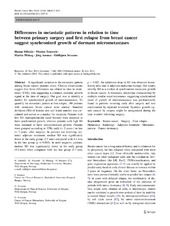| dc.contributor.author | Dillekås, Hanna Elisabet | en_US |
| dc.contributor.author | Transeth, Monica | en_US |
| dc.contributor.author | Pilskog, Martin | en_US |
| dc.contributor.author | Assmus, Jørg | en_US |
| dc.contributor.author | Straume, Oddbjørn | en_US |
| dc.date.accessioned | 2015-03-26T11:50:58Z | |
| dc.date.available | 2015-03-26T11:50:58Z | |
| dc.date.issued | 2014-08 | eng |
| dc.identifier.issn | 0167-6806 | |
| dc.identifier.uri | https://hdl.handle.net/1956/9664 | |
| dc.description.abstract | A significant variation in the metastatic pattern among breast cancer patients exists. Clinical observations suggest that these differences are related to time to recurrence (TTR), thus suggesting a common systemic growth signal at the time of surgery. Our goal was to identify a marker for synchronized growth of micrometastases. To quantify the metastatic pattern at first relapse, 180 patients with metastatic breast cancer were studied. Standard deviation (SD) of lesions size and lesion number was calculated and served as a marker for variation. Patients with low SD (multiple/similar sized lesions) were assumed to have synchronized growth, whereas patients with high SD were assumed to have unsynchronized growth. Patients were grouped according to TTR; early (< 3 years-) or late (> 3 years- after surgery). In patients not receiving systemic adjuvant treatment, median SD was significantly lower in the early group (2.5 mm) compared with 6.4 mm in the late group (p = 0.005). In node negative patients, median SD was significantly lower in the early group (3.0 mm) when compared with the late group (5.7 mm, p = 0.02). An additional drop in SD was observed immediately after end of adjuvant endocrine therapy. Our results identify SD as a marker of synchronized metastatic growth in breast cancer. A metastatic phenotype characterized by multiple similar sized metastases, suggesting synchronized onset of growth of micrometastases was predominantly found in patients recurring early after surgery and was counteracted by adjuvant treatment. Systemic growth signals caused by surgery might be antagonized during the time window following surgery. | en_US |
| dc.language.iso | eng | eng |
| dc.publisher | Springer | eng |
| dc.rights | Attribution-NonCommercial CC BY-NC | eng |
| dc.rights.uri | http://creativecommons.org/licenses/by-nc/4.0/ | eng |
| dc.subject | Breast cancer | eng |
| dc.subject | Surgery | eng |
| dc.subject | First relapse | eng |
| dc.subject | Metastases | eng |
| dc.subject | Radiology | eng |
| dc.subject | Adjuvant treatment | eng |
| dc.subject | Metastatic pattern | eng |
| dc.subject | Tumor dormancy | eng |
| dc.title | Differences in metastatic patterns in relation to time between primary surgery and first relapse from breast cancer suggest synchronized growth of dormant micrometastases | en_US |
| dc.type | Peer reviewed | |
| dc.type | Journal article | |
| dc.date.updated | 2015-03-05T07:42:37Z | en_US |
| dc.description.version | publishedVersion | en_US |
| dc.rights.holder | Copyright 2014 The Authors | |
| dc.identifier.doi | https://doi.org/10.1007/s10549-014-3057-9 | |
| dc.identifier.cristin | 1152856 | |
| dc.source.journal | Breast Cancer Research and Treatment | |
| dc.source.40 | 146 | |
| dc.source.14 | 3 | |
| dc.source.pagenumber | 627-636 | |
| dc.subject.nsi | VDP::Medical sciences: 700::Clinical medical sciences: 750::Oncology: 762 | eng |
| dc.subject.nsi | VDP::Medisinske fag: 700::Klinisk medisinske fag: 750::Onkologi: 762 | nob |

